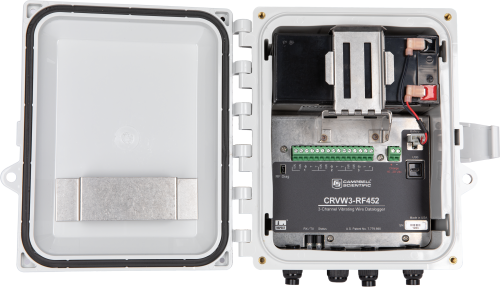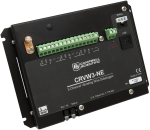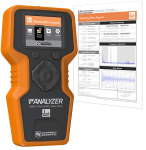Due to electronic component shortage, this product is temporarily unavailable for online quotes and orders.

Using patented VSPECT® technology






Overview
The CRVW3 is a self-contained, low-cost, three-channel vibrating wire data logger. It is designed to be an independent data logger, or a component of your larger radio-linked data-acquisition network when it is configured with available wireless communication options. The CRVW3 includes a factory-integrated power supply and a weatherproof enclosure.
Learn about our patented VSPECT® spectral-analysis technology at our VSPECT® Essentials web resource.
The dynamic vibrating wire measurement technique is protected under U.S. Patent No. 8,671,758, and the vibrating wire spectral-analysis technology (VSPECT®) is protected under U.S. Patent No. 7,779,690.
Read MoreBenefits and Features
- Reads and stores data from one to three vibrating wire sensors
- Charge regulator included for solar panel connection
- Enclosure rated to IP66
- Simple programming interface
- Integrated rechargeable or alkaline battery options
- Compatible with many existing Campbell Scientific data acquisition networks
- PakBus router/radio repeater capabilities
Images







Technical Description
The CRVW3 uses vibrating wire spectral-analysis technology (VSPECT®) to provide the best measurement possible for vibrating wire sensors. VSPECT® observes the incoming sensor signal, performs a Fourier transform and a spectral analysis (transforming the time series into individual sinusoidal components in the frequency spectrum), and determines the sensor frequency by identifying the strongest signal in the acceptable range while filtering out environmental and electrical noise.
The CRVW3 provides the following data: the resonant sensor frequency, thermistor resistance for temperature calculation, and diagnostic values to help determine the validity of the frequency measurement.
Note: The CRVW3 requires Device Configuration Utility (DevConfig) v 2.10 or later. When radio options are used, the CRVW3 requires LoggerNet v 4.3 or later.
Specifications
| -NOTE- |
|
| Operating Temperature Range |
|
| Processor | ST ARM CORTEX-M4 (32-bit with hardware FPU, running at 144 MHz) |
| Data Storage | 16 MB serial flash, up to 420,000 records (single channel), up to 160,000 records (3 channels) |
| Real-Time Clock Accuracy | ±3 min. per year |
| Measurement Interval Range | 1 s to 1 day |
| USB Micro B | Direct connect to PC (supplies power for configuration and data collection), 2.0 full speed, 12 Mbps |
| Configuration | Software configurable, no programming required |
| Compliance | RoHS |
| Warranty | One year against defects in materials and workmanship |
| Weatherproof Enclosure Rating | NEMA 4X (IP66) with proper use of cable entry points |
| Enclosure Mounting | Stainless-steel universal mount for pole/wall mount (optional) or plastic mounting tabs (included) |
| Static Vibrating Wire Measurements | Supported |
| Enclosure Dimensions | 24.1 x 22.9 x 14.0 cm (9.5 x 9.0 x 5.5 in.) |
| Weight |
|
Power |
|
| Charge Terminal | 16 to 28 Vdc (from solar panel or dc power converter) |
| Battery Options | Rechargeable 7 Ah or 8 D-cell alkaline |
| Current Drain |
|
Measurements |
|
| Channel Count | 3 vibrating wire (VW) and 3 thermistor/RTD (temperature) measurements |
| Measurement Speed | 1 s per sensor (VW and temperature) |
Measurements - Vibrating Wire |
|
| Measurement Excitation Options | 2 V (±1 V), 5 V (±2.5 V),12 V (±6 V) |
| Measurement (Frequency) Resolution | 0.001 Hz RMS (-40° to +70°C) |
| Time-series Basic Resolution | 24-bit ADC |
| Measurement Accuracy | ±0.005% of reading (-40° to +70°C) |
| Measurement Method | VSPECT® (Spectral Analysis), U.S. Patent No. 7,779,690, includes diagnostic data |
Measurements - Temperature (Resistance) |
|
| -NOTE- | Thermistor or RTD resistance can be scaled to Temperature (Deg C) per manufacturer specifications. The resulting temperature can be used as a correction factor for the sensor’s output. |
| Measurement Method | Half-bridge ratiometric, 24-bit ADC, built-in completion resistor 4.99 kΩ 0.1% |
| Thermistor Precision | 0.020 Ω RMS @ 3000 Ω (~0.00015 °C RMS for most vibrating wire thermistors) |
| Accuracy | ±0.15% of reading (-40° to +70°C) |
-RF407 Option |
|
| Internal Radio Description | 5 to 250 mW, user selectable; 902 to 928 MHz license-free band, frequency hopping spread-spectrum radio |
| Radio Repeater | Devices with the -RF407 option can be set up as a radio repeater. |
| Where Used | US, Canada |
| Compliance Information |
|
-RF412 Option |
|
| Internal Radio Description | 5 to 250 mW, user selectable; 915 to 928 MHz license-free band, frequency hopping spread-spectrum radio |
| Radio Repeater | Devices with the -RF412 option can be set up as a radio repeater. |
| Where Used | Australia |
| Compliance Information |
|
-RF422 Option |
|
| Internal Radio Description | 2 to 25 mW, user selectable; 863 to 870 MHz license-free band, frequency hopping spread-spectrum radio |
| Where Used | Europe and some of Asia (ETSI) |
| EU Conformity | View the EU Declaration of Conformity in the Documents section of the web page. |
-RF452 Option |
|
| Internal Radio Description | 10 to 1,000 mW, user selectable; 902 to 928 MHz license-free band, frequency hopping spread-spectrum radio |
| Radio Repeater | Devices with the -RF452 option can be set up as a radio repeater. |
| Where Used | US, Canada, Australia |
| Compliance Information |
|
Compatibility
Sensors
The CRVW3 Vibrating Wire Datalogger is capable of measuring the most common vibrating wire sensors including, but not limited to, strain gages, piezometers, pressure transducers, tiltmeters, crackmeters, and load cells. The CRVW3 has three sensor inputs; each sensor input includes a vibrating wire sensor connection and a thermistor connection. The channels are easily configured for traditional sensors. Individual channels can be adjusted to read only the vibrating wire sensor, or they may be turned off completely.
Network Considerations
The CRVW3 can be ordered with several wireless communication options. The following table illustrates wireless communications compatibilities in terms of networks.
CRVW3 Network Compatibility
| RF400a | RF401A RF401a RF430a |
RF407 | RF411A RF410a RF411a RF431a |
RF412 | RF416 RF432a RF415a |
RF422 | RF450a RF451a RF452 |
|
| CRVW3-RF407 |  |
|||||||
| CRVW3-RF412 |  |
|||||||
| CRVW3-RF422 |  |
|||||||
| CRVW3-RF451 |  |
|||||||
| CRVW3-RF452 |  |
Notes: aRetired product; no longer available.
Enclosure Considerations
The CRVW3 comes in a package designed for field deployment. The electronics, battery, and electrical connections are all contained within the enclosure. The CRVW3 is supplied with a basic mounting kit, or a metal universal mounting bracket can be added to facilitate installation on a post or wall.
Power Considerations
The CRVW3 can be ordered with either a rechargeable battery or a D-cell alkaline battery pack. When the rechargeable battery is used, the CRVW3 can be easily wired to a solar panel, and the rechargeable battery will be charged using the built-in regulator on the CRVW3.
Resources and Links
Product Brochures
Technical Papers
Compliance
Downloads
Device Configuration Utility v.2.29 (54 MB) 15-11-2023
A software utility used to download operating systems and set up Campbell Scientific hardware. Also will update PakBus Graph and the Network Planner if they have been installed previously by another Campbell Scientific software package.
Supported Operating Systems:
Windows 11 or 10 (Both 32 and 64 bit)
CRVWx Firmware v.4.04 (931 KB) 09-05-2023
Current version of the CRVWx firmware. Requires the Device Configuration Utility to upload the firmware to the CRVWx.
FAQs for
Number of FAQs related to CRVW3: 11
Expand AllCollapse All
-
Yes. The batteries can be switched at any time between the D-cell battery option and the rechargeable battery option.
-
The communications options (such as –RF451) reflect how the CRVW3 is built during the manufacturing process. After a CRVW3 is ordered with a specific communications option, it retains that option. It is possible to turn off the wireless communications, and the CRVW3 can be deployed as a stand-alone data logger.
-
The CRVW3 takes approximately 1 s to measure the vibrating wire sensor and thermistor. If all three channels are measuring sensors, the CRVW3 takes approximately 3 s to measure the sensors before it is ready to begin the cycle again.
-
No. The CRVW3 is designed to be a simple, quickly deployed system with minimal modifications. The simple design of the CRVW3 does not enable it for use with multiplexers. When an application requires multiplexers, consider using a CR6 Measurement and Control Datalogger instead.
-
No. The CRVW3 has built-in memory and can be configured in a variety of ways. It can measure data frequently and communicate the data at a slower rate (for example, measure every 10 minutes and communicate the results once per day). The CRVW3 can also communicate data after each measurement is taken. The ability to configure the communications on a network to an application's specific needs allows the user to better manage the power consumption on the CRVW3, as well as on the base data logger.
-
Yes. The CRVW3 can be used as a stand-alone data logger. If the CRVW3 is not connected to a network, data is collected by connecting directly to the CRVW3 (via USB) or through a simple wireless connection, as outlined in the manual.
-
Yes. The CRVW3 is a PakBus device that can communicate with other PakBus data loggers. The neighbor data logger requires a radio device compatible with the CRVW3 radio option. If a CRVW3-RF451 model is used, the neighbor device needs to have an RF450 or RF451 radio installed to enable wireless communications. After connecting to the first neighbor, PakBus routing can be used to reach other PakBus devices available to that neighbor via any type of active communications link (TCP/IP, WiFi, etc.) Network Planner is a tool within LoggerNet used to design a network and explore how devices communicate.
-
Not much. The CRVW3 needs to be configured, installed, and wired at the site. These steps have been outlined in the Quick Deploy guide that ships with the CRVW3 and is also available for download on this website. The manual is a more detailed resource to address any installation questions.
-
There are multiple communication options depending on how the CRVW3 is ordered. All CRVW3 devices can communicate data and be configured using the built-in USB connection. If a CRVW3 is ordered with a wireless communication option, it can also communicate the data wirelessly to a PC or another data logger.
-
Yes. To connect with an existing network, it is important to use the same or compatible radios. If an older radio model is used on the network, the radios can be updated to a more recent model, or two types of radios can be used with a single data logger to act as a radio technology bridge (gateway). For example, a CR1000 with an RF401 and RF450 can be used to communicate with older RF401-compatible devices and also with the CRVW3-RF451.
Articles and Press Releases
Privacy Policy Update
We've updated our privacy policy. Learn More
Cookie Consent
Update your cookie preferences. Update Cookie Preferences






